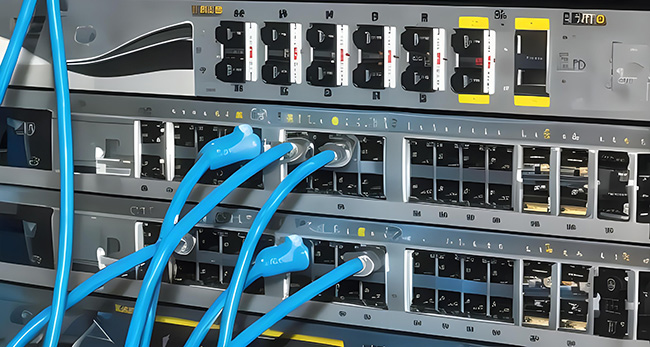Industrial Switch, as critical communication devices, plays a crucial role in the industrial field. According to different needs and application scenarios, industrial switches can be classified into multiple categories. This article will explore the classification of industrial switches and introduce the specific applications of each type of switch in different application fields, helping readers better understand the diversity and applicability of industrial switches.
Compared to ordinary switches, industrial switches emphasize stability and anti-interference ability, and can operate for long periods of time in harsh industrial environments. They are specifically designed for industrial automation applications, with higher anti-interference ability and stability, and support industrial protocols such as PROFINET and Modbus. It usually has the characteristics of dust and water resistance, humidity resistance, and electromagnetic interference resistance, and is suitable for industrial applications in harsh environments such as railways, mines, and aerospace.
1. Classified by function
Unmanaged industrial switch: Unmanaged industrial switch is the most basic type of switch, which has the most basic switching functions. They usually do not provide additional management functions and are suitable for scenarios with low network management requirements, such as small factories or office networks.
Managed industrial switches: Managed industrial switches have more advanced management and configuration functions, and can provide more flexible, secure, and stable network services. They typically have advanced features such as remote management, virtual local area networks (VLANs), and are suitable for medium to large industrial networks.
2. Classified by the number of ports
Conventional switches: Conventional switches typically have dozens to hundreds of ports and are suitable for medium to large industrial networks. They have high throughput and data forwarding capabilities, which can meet the communication needs in complex network environments.
Mini switches: Mini switches typically have several to a dozen ports and are suitable for small factories or office networks. They are compact, easy to install and manage, and suitable for scenarios with lower requirements for network size and cost.
Classification and application fields of industrial switches

3. Classify by network type
Ethernet switch: Ethernet switch is the most common type of switch used for Ethernet protocol based local area networks (LANs). They have good interconnectivity and scalability, and can meet the communication needs of most industrial networks.
Wireless switch: Wireless switch communicates through wireless signals and is suitable for wireless network construction. They are typically used in conjunction with wireless access points (APs) to enable mobile devices to wirelessly connect to industrial networks, making them suitable for scenarios that require mobility and flexibility, such as warehouse management and logistics tracking.
4. Classify by rate
10/100Mbps switch: The speed of the 10/100Mbps switch is 10Mbps or 100Mbps, suitable for industrial networks with lower requirements. They can be compatible with old devices and provide basic data forwarding and communication functions.
Gigabit Ethernet switch: The speed of a Gigabit Ethernet switch is 1000Mbps (i.e. 1Gbps), which has higher bandwidth and data transfer rate. They are suitable for industrial applications that require high network speed, such as high-definition video transmission and high-capacity data transmission.
10 Gigabit Ethernet switch: A 10 Gigabit Ethernet switch refers to a device that can provide a throughput of over 10 gigabytes in just one second. As the core device of the network, 10 Gigabit Ethernet switches not only support 10 Gigabit access modules on existing Gigabit Ethernet switches, but also require a new generation of system design, including updates to switch architecture, layer 2/3 technology, default support for next-generation IPv6, and effective bandwidth management.
5. Classified by port type:
Fiber optic switch: mainly used for long-distance data transmission, with high anti-interference ability and stability, suitable for industrial environments that require long-distance connections.
Copper cable switch: suitable for short distance connections, relatively low in price, commonly used in industrial control rooms and workshops.
Application field:
1. Manufacturing: Industrial switches play a crucial role in the manufacturing industry, connecting various industrial equipment such as robots, PLC controllers, sensors, etc. They can achieve real-time data transmission and remote monitoring, improve production efficiency and quality management.
2. Logistics and warehousing: In the field of logistics and warehousing, industrial switches can achieve smooth information flow and logistics tracking. By connecting various devices and management software, automation and intelligence of warehousing equipment can be achieved.
3. Energy and Public Utilities: In the field of energy and public utilities, industrial switches can build reliable communication networks to achieve remote monitoring and control. They can achieve intelligent management and optimization of energy supply.
Conclusion: Industrial switches have diverse classifications and can meet the needs of different industrial application scenarios. Based on factors such as functionality, number of ports, network type, and speed, suitable industrial switches can be selected to achieve efficient network communication and management. Whether in manufacturing, logistics and warehousing, or energy and utilities, industrial switches play an indispensable role in providing stable, safe, and efficient communication support for industrial production and operation.
Contact: sales
Phone: 18688787693
E-mail: sales@hsindustrialswitch.com
Add: Room 608, Building B,GaoXinQi TEC Park,Baoan District, ShenZhen,China